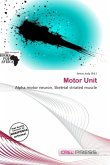Please note that the content of this book primarily consists of articles available from Wikipedia or other free sources online. The motor unit consists of a voluntary alpha motoneuron and all of the collective muscle fibers that it controls, known as the effector muscle. The alpha motoneuron communicates with acetylcholine receptors on the motor end plate of the effector muscle. Reception of acetylcholine neurotransmitters on the motor end plate causes contraction of that effector muscle. Motor unit plasticity is defined as the ability of motoneurons and their respective effector muscles to physically and functionally change as a result of activity, age, and other factors. Motor unit plasticity has implications for improved athletic performance and resistance to immobility as a result of age. Recent advanced training techniques and physical therapy techniques that focus on improving neural function in addition to muscular function show promising results to improving athletic performances and extending mobility for the elderly.








